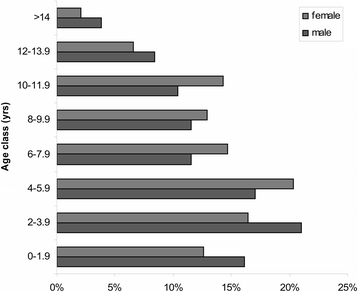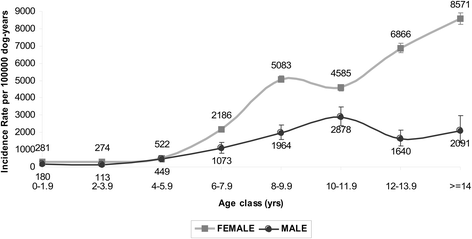Estimating canine cancer incidence: findings from a population-based tumour registry in northwestern Italy
- PMID: 28659149
- PMCID: PMC5490209
- DOI: 10.1186/s12917-017-1126-0
Estimating canine cancer incidence: findings from a population-based tumour registry in northwestern Italy
Abstract
Background: Canine cancer registry data can be put to good use in epidemiological studies. Quantitative comparison of tumour types may reveal unusual cancer frequencies, providing directions for research and generation of hypotheses of cancer causation in a specific area, and suggest leads for identifying risk factors. Here we report canine cancer incidence rates calculated from a population-based registry in an area without any known specific environmental hazard.
Results: In its 90 months of operation from 2001 to 2008 (the observation period in this study), the population-based Piedmont Canine Cancer Registry collected data on 1175 tumours confirmed by histopathological diagnosis. The incidence rate was 804 per 100,000 dog-years for malignant tumours and 897 per 100,000 dog-years for benign tumours. Higher rates for all cancers were observed in purebred dogs, particularly in Yorkshire terrier and Boxer. The most prevalent malignant neoplasms were cutaneous mastocytoma and hemangiopericytoma, and mammary gland complex carcinoma and simplex carcinoma.
Conclusions: The Piedmont canine cancer registry is one of few of its kind whose operations have been consistently supported by long-term public funding. The registry-based cancer incidence rates were estimated with particular attention to the validity of data collection, thus minimizing the potential for bias. The findings on cancer incidence rates may provide a reliable reference for comparison studies. Researches conducted on dogs, used as sentinels for community exposure to environmental carcinogens, can be useful to detect excess risks in the incidence of malignant tumours in the human population.
Keywords: Cancer epidemiology; Dog; Incidence; Population-based cancer registry; Sentinel animal; Tumours.
Conflict of interest statement
Ethics approval and consent to participate
No animal care and use committee approval was required because the data used by Istituto Zooprofilattico Sperimentale del Piemonte, Liguria e Valle d’Aosta came from histopathological results collected during the study period. The Institute was given permission by veterinary practitioners and dog owners to use their histopathological results for research purposes.
Consent for publication
Not applicable.
Competing interests
The authors declare that they have no competing interests.
Publisher’s Note
Springer Nature remains neutral with regard to jurisdictional claims in published maps and institutional affiliations.
Figures





References
MeSH terms
LinkOut - more resources
Full Text Sources
Other Literature Sources

